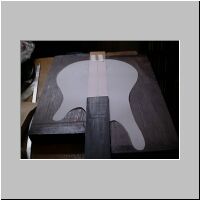
Click to enlarge |
Here's the bass (yes, it actually looks like one now!!) after removing the sash clamps. The
joint came out perfectly, and very, very strong!! The glue manufacturers claim that the
glue is far stronger than the wood you glue with it - and I don't doubt it for a minute.
There is a dilemma in the guitar-making community regarding glues. You can glue things like
the fingerboard on with standard aliphatic wood glues, which 'pull' the wood together as
they dry. If there is a problem, it is possible to separate the joint with a bit of effort,
fix the problem then re-glue. Epoxy is far stronger, and it would not be possible to
separate the wood should a problem arise. However, someone wise once said - get it right
the first time, and you won't need to separate the joint...
|








